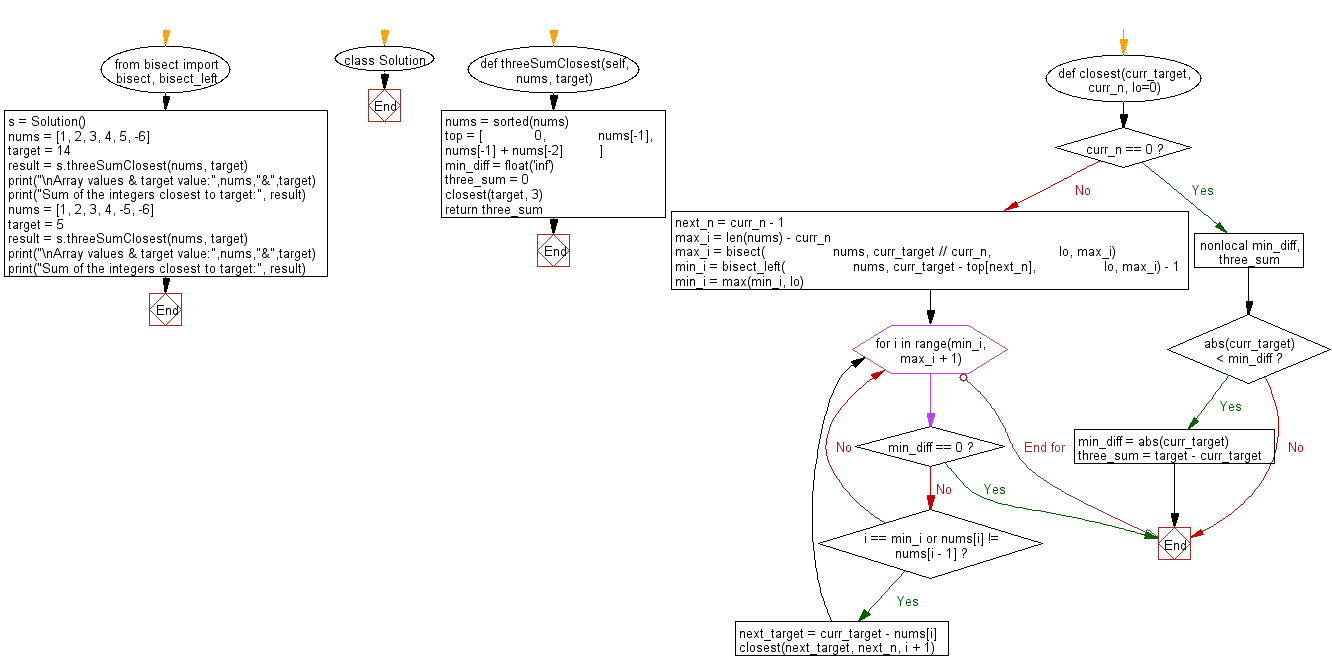Python Bisect: Find a triplet in an array such that the sum is closest to a given number
Python Bisect: Exercise-8 with Solution
Write a Python program to find a triplet in an array such that the sum is closest to a given number. Return the sum of the three integers.
Sample Solution:
Python Code:
#Source: https://bit.ly/2SRefdb
from bisect import bisect, bisect_left
class Solution:
def threeSumClosest(self, nums, target):
"""
:type nums: List[int]
:type target: int
:rtype: int
"""
nums = sorted(nums)
# Let top[i] be the sum of largest i numbers.
top = [
0,
nums[-1],
nums[-1] + nums[-2]
]
min_diff = float('inf')
three_sum = 0
# Find range of the least number in curr_n (0, 1, 2 or 3)
# numbers that sum up to curr_target, then find range of
# 2nd least number and so on by recursion.
def closest(curr_target, curr_n, lo=0):
if curr_n == 0:
nonlocal min_diff, three_sum
if abs(curr_target) < min_diff:
min_diff = abs(curr_target)
three_sum = target - curr_target
return
next_n = curr_n - 1
max_i = len(nums) - curr_n
max_i = bisect(
nums, curr_target // curr_n,
lo, max_i)
min_i = bisect_left(
nums, curr_target - top[next_n],
lo, max_i) - 1
min_i = max(min_i, lo)
for i in range(min_i, max_i + 1):
if min_diff == 0:
return
if i == min_i or nums[i] != nums[i - 1]:
next_target = curr_target - nums[i]
closest(next_target, next_n, i + 1)
closest(target, 3)
return three_sum
s = Solution()
nums = [1, 2, 3, 4, 5, -6]
target = 14
result = s.threeSumClosest(nums, target)
print("\nArray values & target value:",nums,"&",target)
print("Sum of the integers closest to target:", result)
nums = [1, 2, 3, 4, -5, -6]
target = 5
result = s.threeSumClosest(nums, target)
print("\nArray values & target value:",nums,"&",target)
print("Sum of the integers closest to target:", result)
Sample Output:
Array values & target value: [1, 2, 3, 4, 5, -6] & 14 Sum of the integers closest to target: 12 Array values & target value: [1, 2, 3, 4, -5, -6] & 5 Sum of the integers closest to target: 6
Flowchart:

Visualize Python code execution:
The following tool visualize what the computer is doing step-by-step as it executes the said program:
Python Code Editor:
Contribute your code and comments through Disqus.
Next: Write a Python program to find four elements from a given array of integers whose sum is equal to a given number. The solution set must not contain duplicate quadruplets.What is the difficulty level of this exercise?
Test your Programming skills with w3resource's quiz.
Python: Tips of the Day
Find current directory and file's directory:
To get the full path to the directory a Python file is contained in, write this in that file:
import os dir_path = os.path.dirname(os.path.realpath(__file__))
(Note that the incantation above won't work if you've already used os.chdir() to change your current working directory, since the value of the __file__ constant is relative to the current working directory and is not changed by an os.chdir() call.)
To get the current working directory use
import os cwd = os.getcwd()
Documentation references for the modules, constants and functions used above:
- The os and os.path modules.
- The __file__ constant
- os.path.realpath(path) (returns "the canonical path of the specified filename, eliminating any symbolic links encountered in the path")
- os.path.dirname(path) (returns "the directory name of pathname path")
- os.getcwd() (returns "a string representing the current working directory")
- os.chdir(path) ("change the current working directory to path")
Ref: https://bit.ly/3fy0R6m
- New Content published on w3resource:
- HTML-CSS Practical: Exercises, Practice, Solution
- Java Regular Expression: Exercises, Practice, Solution
- Scala Programming Exercises, Practice, Solution
- Python Itertools exercises
- Python Numpy exercises
- Python GeoPy Package exercises
- Python Pandas exercises
- Python nltk exercises
- Python BeautifulSoup exercises
- Form Template
- Composer - PHP Package Manager
- PHPUnit - PHP Testing
- Laravel - PHP Framework
- Angular - JavaScript Framework
- Vue - JavaScript Framework
- Jest - JavaScript Testing Framework
